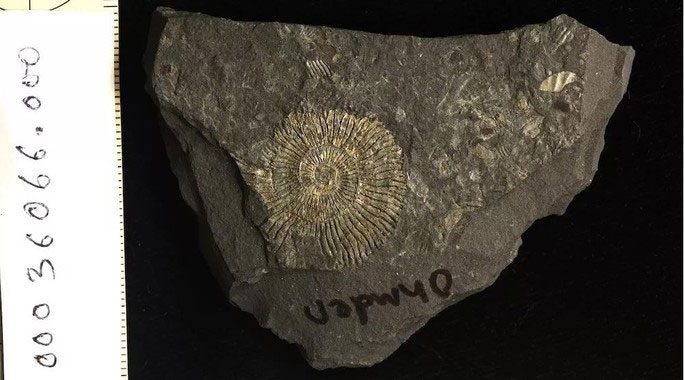Posidonia Shale is a renowned site in Germany famous for its stunning “golden” fossils, which preserve small Jurassic creatures naturally transformed into glimmering objects resembling solid gold.
An international team of scientists has decided to explore the mysteries of Posidonia Shale once again by visiting and examining several fossil samples of small marine creatures approximately 183 million years old, dating back to the middle of the Jurassic period.
Similar to many other specimens from Posidonia Shale, these fossils are well-preserved in a layer of material that sparkles like gold.

One of the uniquely fossilized small creatures at Posidonia Shale – (Photo: Sinjini Sinha)
Researchers previously believed that the material was not gold as we use for jewelry but rather “fool’s gold,” referring to pyrite, a mineral that resembles gold.
However, the latest examination results indicate that these organisms were not pyritized as previously thought.
“Strangely, there is a little pyrite on some samples, but basically, all are phosphate calcite or other yellow compounds from the same group,” said Associate Professor Rowan Martindale from the Department of Geological Sciences at the University of Texas in Austin, a member of the research team, in an interview with Live Science.
Professor Martindale noted that this was a shock to the entire team after analyzing all 70 different fossilized small creatures. The tiny clusters of pyrite are so minuscule that the newly discovered minerals are what provide the striking golden color.
Previously, it was assumed to be pyrite not only because of its striking resemblance but also because pyritization occurs in oxygen-deficient environments, which aligns perfectly with the samples found in this black shale.
The new research reveals that although Posidonia Shale is indeed an ancient anoxic seafloor setting conducive to fossilization, it required an oxygen explosion event to act as a “trigger” for fossilization reactions to occur. This is why phosphate minerals dominate and create the gold-like fossil forms.
However, even though these fossilized small creatures are neither gold nor fool’s gold, they remain incredibly valuable due to their Jurassic age, perfect preservation, and rare beauty.
The research has just been published in the journal Earth Science Reviews.


















































